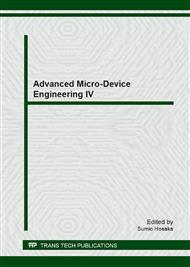[1]
W.J. Dally and J.W. Poulton : Digital systems engineering, Cambridge, (1998).
Google Scholar
[2]
Ramin Farjad-Rad, et al., 0. 622-8. 0Gbps 150mW serial IO macrocell with fully flexible preemphasis and equalization, ', Symposium on VLSI circuits, pp.63-66, (2003).
DOI: 10.1109/vlsic.2003.1221162
Google Scholar
[3]
R. Sun, J. Park, F. O'Mahony, C. Yue, A low-power, 20-Gb/s continuous-time adaptive passive equalizer, ', IEEE International Symposium on Circuits and Systems, pp.920-923, (2005).
DOI: 10.1109/iscas.2005.1464739
Google Scholar
[4]
M. Kameyama, T. Hanyu and T. Aoki, Multiple-valued logic as a new computing paradigm -- A brief survey of Higuchi's research on multiple-valued logic, Journal of Multiple-Valued Logic and Soft Computing, Vol. 11, pp.407-436, (2005).
DOI: 10.1109/ismvl.2003.1201407
Google Scholar
[5]
Y. Yuminaka and K. Yamamura, Equalization techniques for multiple-valued data transmission and their application, ', Journal of Multiple-Valued Logic and Soft Computing, Vol. 13, pp.569-582, (2007).
DOI: 10.1109/ismvl.2007.17
Google Scholar
[6]
A. Lender, The duobinary technique for high-speed data transmission, ', IEEE Trans. Commun. Electron., Vol. 82, pp.214-218, (1963).
DOI: 10.1109/tce.1963.6373379
Google Scholar
[7]
Jri Lee, M. Chen, and H. Wang, Design and comparison of three 20-Gb/s backplane transceivers for Duobinary, PAM4, and NRZ data, ', IEEE Journal of Solid-State Circuits, 43, pp.2120-2133, (2008).
DOI: 10.1109/jssc.2008.2001934
Google Scholar
[8]
K. Yamaguchi et al., 12 Gb/s duobinary signaling with x2 oversampled edge equalization, ', IEEE ISSCC Dig. Tech. Papers, pp.70-71, (2005).
DOI: 10.1109/isscc.2005.1493873
Google Scholar
[9]
Y. Yuminaka and K. Kawano, A bandwidth-efficient ternary signaling scheme for 1-D partialresponse channels, ', Journal of Multiple-Valued Logic and Soft Computing, Vol. 19, No. 1-3, pp.271-282, (2012).
Google Scholar
[10]
K. Kanda, D. Antono, K. Ishida, H. Kawaguchi, T. Kuroda, and T. Sakurai, 1. 27 gb/s/pin 3 mw/pin wireless superconnect (wsc) interface scheme, ', IEEE ISSCC Dig. Tech. Papers, pp.186-187, (2003).
DOI: 10.1109/isscc.2003.1234260
Google Scholar


